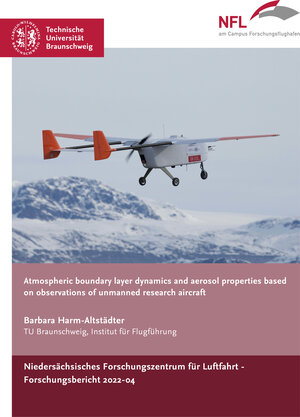Atmospheric boundary layer dynamics and aerosol properties based on observations of unmanned research aircraft
von Barbara Harm-AltstädterAbstract
The outline of the thesis considers a characterization of dynamic processes and aerosol particles
that were studied with unmanned aerial systems (UAS) in the atmospheric boundary 1ayer (ABL) at two
investigation areas; in the polar region and at a continental site in Middle Europe. The use of UAS
provides a detailed 4-D picture of ABL properties, thus offers a high potential for Billing the
sparse small-scale observations that exist in the ABL due to missing measurement tools. The Carolo
T200 ”M²AV” (Mini Meteorological Aerial Vehicle) was applied for ABL profiling and investigations
of turbulence parameters as part of a I? olarstern cruise in the Antarctic Weddell-Sea during polar
night between 8 June and 12 August 2013. Eleven research flights were carried out with the M AV but
the field activity was strongly affected by a multitude of critical challenges like ic- ing, strong
wind speed and externally driven limitations, mainly influenced by the need of a suitable airfield
on sea ice. The results address a detailed inves- tigation of the ABL's stability, measured above
closed sea ice and above open water sections at two different sites on 11 July and 1—2 August 2013.
The obser- vations are strongly questioning the common picture of a stably stratified ABL, as
generally assumed in models that are applied for polar areas. Since October 2013, the UAS Carolo
P360 ”ALADINA” (Application of Light-weight Aircraft for Detecting IN-situ Aerosol) was operated
for more than 100 research flights at the Leibniz Institute for Tropospheric Research (TROPOS) site
in Melpitz, Ger- many. The main focus of the study is on investigating the correlation between
ABL's properties and the new particle formation (NPF). This was primarily re- alized by targeting
vertical profiles of ultrafine aerosol particles (UFP, usual size
< 50 nm) in the lowermost 1 km. According to different selected case studies, a high variability of
the observed UFP was identified in the vertical scale and the major impact on the distribution was
linked to dynamics of the ABL. In addi- tion, frequently performed profiles of the measured UFP
enabled to determine transport and mixing processes. For instance, UFP were lifted upwards from the
ground or transported downwards mainly originated from the inversion layer or mixed in short time
in the whole ABL. Further, to a significant degree of the ALADINA's measurement period, NPF events
would not have been captured by pure ground-based observations.
The outline of the thesis considers a characterization of dynamic processes and aerosol particles
that were studied with unmanned aerial systems (UAS) in the atmospheric boundary 1ayer (ABL) at two
investigation areas; in the polar region and at a continental site in Middle Europe. The use of UAS
provides a detailed 4-D picture of ABL properties, thus offers a high potential for Billing the
sparse small-scale observations that exist in the ABL due to missing measurement tools. The Carolo
T200 ”M²AV” (Mini Meteorological Aerial Vehicle) was applied for ABL profiling and investigations
of turbulence parameters as part of a I? olarstern cruise in the Antarctic Weddell-Sea during polar
night between 8 June and 12 August 2013. Eleven research flights were carried out with the M AV but
the field activity was strongly affected by a multitude of critical challenges like ic- ing, strong
wind speed and externally driven limitations, mainly influenced by the need of a suitable airfield
on sea ice. The results address a detailed inves- tigation of the ABL's stability, measured above
closed sea ice and above open water sections at two different sites on 11 July and 1—2 August 2013.
The obser- vations are strongly questioning the common picture of a stably stratified ABL, as
generally assumed in models that are applied for polar areas. Since October 2013, the UAS Carolo
P360 ”ALADINA” (Application of Light-weight Aircraft for Detecting IN-situ Aerosol) was operated
for more than 100 research flights at the Leibniz Institute for Tropospheric Research (TROPOS) site
in Melpitz, Ger- many. The main focus of the study is on investigating the correlation between
ABL's properties and the new particle formation (NPF). This was primarily re- alized by targeting
vertical profiles of ultrafine aerosol particles (UFP, usual size
< 50 nm) in the lowermost 1 km. According to different selected case studies, a high variability of
the observed UFP was identified in the vertical scale and the major impact on the distribution was
linked to dynamics of the ABL. In addi- tion, frequently performed profiles of the measured UFP
enabled to determine transport and mixing processes. For instance, UFP were lifted upwards from the
ground or transported downwards mainly originated from the inversion layer or mixed in short time
in the whole ABL. Further, to a significant degree of the ALADINA's measurement period, NPF events
would not have been captured by pure ground-based observations.






